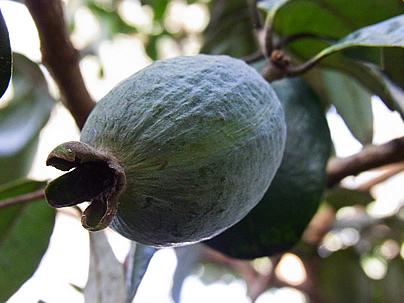The Pineapple Guava (Acca sellowiana) is a fruit-bearing shrub or small tree, evergreen, native to the highland regions of southern Brazil, Argentina, Paraguay, and Uruguay. It is a member of the Myrtaceae family, just like the pitanga, jabuticaba, and guava. Known for its fragrant and tasty fruits, it is widely consumed in Europe, the United States, and Oceania, particularly in New Zealand, its main producer and consumer market.
Despite being native, it is still little known and rare in South America. This is attributed to the fact that it is a plant that is still not widely domesticated, and its fruits are highly perishable after harvesting, lasting no more than two weeks. In Brazil, there are about 4 improved cultivars produced by EPAGRI in Santa Catarina. New Zealand, on the other hand, is much further ahead, with over 30 productive cultivars and many others in development.
It features a branched trunk with grey bark, reaching 6.6 to 16.4 feet (2 to 5 meters) in height. The crown is dense, with opposite, elliptical, and leathery leaves with short petioles. The upper side of the leaves is green, while the underside is pale, silver-colored. It flowers in the summer, producing beautiful flowers with fleshy petals and long red stamens, in tufts. Flowers may appear singly or in clusters.
The fruits ripen in autumn and are ellipsoid, juicy, with gelatinous, translucent, and shiny pulp in the center, and granular, white, and opaque near the peel. The peel is green, regardless of whether the fruit is ripe or not. Ripe fruits fall to the ground. To determine the right harvesting time, one should check daily to see if the fruit is slightly softer and detaches easily from the branch. The pulp is sweet and tart, with a delightful fragrance. It is said to resemble the flavors of guava, pineapple, and strawberry.
Each fruit contains 40 to 100 white and hard seeds, similar to those of guava. Both the flowers and fruits are eagerly eaten by wild birds. Pollination is done by bees and birds. Although Pineapple Guava is self-pollinating and capable of producing fruit alone, its productivity is considerably increased if other individuals are available nearby for cross-pollination.

The petals of the Pineapple Guava flowers are sweet and edible too, used in salads and to garnish dishes. The fruit is consumed cooked or more often in natura, simply cut in half and eaten with a spoon, like a delicious dessert. It can be used to prepare juices, smoothies, mousses, jellies, compotes, ice creams, liqueurs, and a variety of culinary preparations.
Ripe fruits can be stored in the refrigerator, but only for a short time, and their pulp can be frozen. Research in various countries identifies Pineapple Guava as a “superfruit,” a food with important properties, due to its content of vitamins, minerals, and antioxidant substances.
Pineapple Guava stands out in landscaping primarily for its beautiful and delicate flowers. It can be used alone, in groups, or even in rows, forming good living fences. It tolerates pruning, which makes the crown denser, although it affects fruit production. To stimulate fruit production, it’s best to keep the crown clean and airy. It’s also ideal for growing in pots, decorating patios, balconies, and other outdoor paved spaces.
It should be cultivated in full sun or partial shade, in fertile, deep soil, enriched with organic matter, and irrigated in the first year of establishment. Once well established, Pineapple Guava tolerates short periods of drought, however, for a higher fruit yield, water should not be lacking during flowering and fruiting. It prefers a subtropical climate, with at least 50 hours of cold for satisfactory fruit production. It is frost-tolerant, suffering only minor damage if frost occurs out of season.
Pineapple Guava is sensitive to strong winds. It can be propagated by seeds, cuttings, and grafting. Seeds germinate 40 to 90 days after planting. Transplant seedlings of 16 inches or more (about 40 cm or more), on cloudy days. Fruit production begins between 4 to 9 years after planting, depending on the origin of the seedlings, the chosen cultivar, and adaptation to the environment, among other factors.


